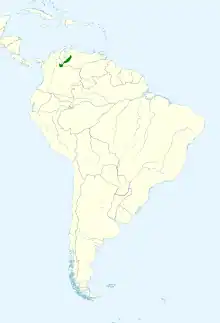| Green inca | |
|---|---|
.jpg.webp) | |
| In Mérida, Venezuela | |
| Scientific classification | |
| Domain: | Eukaryota |
| Kingdom: | Animalia |
| Phylum: | Chordata |
| Class: | Aves |
| Clade: | Strisores |
| Order: | Apodiformes |
| Family: | Trochilidae |
| Genus: | Coeligena |
| Species: | C. conradii |
| Binomial name | |
| Coeligena conradii (Bourcier, 1847) | |
 | |
The green inca (Coeligena conradii) is a species of hummingbird in subfamily Lesbiinae, the so-called "typical hummingbirds", of family Trochilidae. It is found in Colombia and Venezuela.[3]
Taxonomy and systematics
The International Ornithological Committee (IOC), the Clements taxonomy, and BirdLife International's Handbook of the Birds of the World (HBW) recognize the green inca as a species.[3][4][5] The South American Classification Committee of the American Ornithological Society treats it as a subspecies of the collared inca (C. torquata) but is seeking a proposal to recognize it as a species.[6]
Description
The green inca is about 14.5 cm (5.7 in) long; one female specimen weighed 6.7 g (0.24 oz). Adult males are mostly grass green, with a wide white collar across the upper breast. Their outer tail feathers are mostly white with green tips and their wings are brownish. Females are also mostly grass green above but with a smaller white collar and a rusty throat with green spots. The rest of their underparts are grayish with green mottling and spots.[7]
Distribution and habitat
The green inca is found in the Andes of northwestern Venezuela between the states of Trujillo and Táchira and in northern Colombia's Norte de Santander Department. It inhabits the interior and edges of humid montane cloudforest. In elevation it mostly ranges between 1,800 and 3,000 m (5,900 and 9,800 ft) but can be found as low as 1,500 m (4,900 ft).[7]
Behavior
Movement
As far as is known, the green inca is a year-round resident throughout its range.[7]
Feeding
The green inca forages by trap-lining, visiting a circuit of flowering plants. It mostly feeds from the understory to the forest's mid-level but also sometimes in the canopy. It feeds on nectar from Cavendishia, Fuchsia, plants of family Ericaceae, and others such as vines. It also catches insects by hawking from a perch or by gleaning while hovering.[7]
Breeding
Nothing is known about the green inca's breeding biology.[7]
Vocalization
The green inca's most common vocalization is "a squeaky chatter". It also makes "a soft, low, reedy whistle "tu-tee", "a longer series...pip..pip..pip...", "a repeated phrase such as tsi-tsi-tsiririt...tsi-tsi-tsiririt...", and while foraging a "short spit or tsit".[7]
Status
The IUCN has assessed the green inca as being of Least Concern. It has a restricted range and its population size is not known and is believed to be decreasing. No immediate threats have been identified.[1]
References
- 1 2 BirdLife International (2016). "Green Inca Coeligena conradii". The IUCN Red List of Threatened Species. IUCN. 2016: e.T22726729A94930553. doi:10.2305/IUCN.UK.2016-3.RLTS.T22726729A94930553.en. Retrieved 1 February 2023.
- ↑ "Appendices | CITES". cites.org. Retrieved 2022-01-14.
- 1 2 Gill, F.; Donsker, D.; Rasmussen, P., eds. (January 2023). "hummingbirds". IOC World Bird List. v 13.1. Retrieved January 30, 2023.
- ↑ Clements, J. F., T. S. Schulenberg, M. J. Iliff, T. A. Fredericks, J. A. Gerbracht, D. Lepage, S. M. Billerman, B. L. Sullivan, and C. L. Wood. 2022. The eBird/Clements checklist of birds of the world: v2022. Downloaded from https://www.birds.cornell.edu/clementschecklist/download/ retrieved November 10, 2022
- ↑ HBW and BirdLife International (2022) Handbook of the Birds of the World and BirdLife International digital checklist of the birds of the world. Version 7. Available at: http://datazone.birdlife.org/userfiles/file/Species/Taxonomy/HBW-BirdLife_Checklist_v7_Dec22.zip retrieved December 13, 2022
- ↑ Remsen, J. V., Jr., J. I. Areta, E. Bonaccorso, S. Claramunt, A. Jaramillo, D. F. Lane, J. F. Pacheco, M. B. Robbins, F. G. Stiles, and K. J. Zimmer. Version 30 January 2023. A classification of the bird species of South America. American Ornithological Society. https://www.museum.lsu.edu/~Remsen/SACCBaseline.htm retrieved January 30, 2023
- 1 2 3 4 5 6 del Hoyo, J., T. Züchner, N. Collar, E. de Juana, P. F. D. Boesman, and G. M. Kirwan (2022). Green Inca (Coeligena conradii), version 1.0. In Birds of the World (B. K. Keeney, Editor). Cornell Lab of Ornithology, Ithaca, NY, USA. https://doi.org/10.2173/bow.colinc4.01 retrieved February 1, 2023
External links
